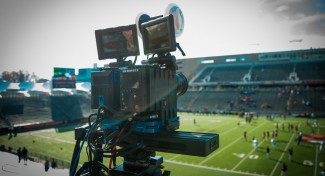Let Me Watch On the Headset I Actually Own

Another pain point for the end-user of VR sports viewing is platform availability. I’m lucky enough to be in a position where I have a good excuse to own every headset under the sun, but—needless to say—most people only have need for a single headset. But the particular headset you own will have a significant impact on which VR sports broadcasts you can actually view.
You might expect that the high-end headsets like the Rift and Vive (costing $500 and up) would be the place where you’d find the majority of this kind of content. But actually the opposite is true. The majority of VR sports broadcasting apps and platforms are available only on Gear VR.
That’s especially weird for owners of the Rift, because both the Rift and Gear VR run stores operated by Oculus; you can imagine it would be frustrating to have shelled out for the high-end headset but not be allowed to access the content that’s available on a much less expensive headset—as if a movie was released only on DVD and your Blu-ray player couldn’t play it.
Weirder yet, Oculus itself has funded VR sports content—like the sports documentary Follow My Lead—that’s exclusively available on Gear VR but not on the Rift.
With support for both Gear VR and Daydream, NextVR actually covers more platforms than most companies doing VR sports broadcasting (which only support single platform), but even then there’s still a majority of leading platforms missing—HTC Vive, PSVR, and the Rift—and there’s a long way to go before you can expect to watch sports in VR no matter what headset you own.
Cole says that—for NextVR anyway—starting with mobile makes sense because it’s easier to target the more technically constrained platform and work your way up, rather than targeting the high-end and then need to heavily optimize your way down.
“…mobile was the hardest to get right—with so much optimization needed to deliver a solid experience that lasts for an entire NBA game or concert. Mobile is development resource-hungry,” he said.

And there’s another huge factor that’s driving a lot of the Gear VR-only action for VR sports broadcasting: it’s the single largest VR platform out there right now, with more than 5 million headsets. If you’re only going to support one platform to start, and want to get as many eyeballs on your content as possible (and you can bet that’s the #1 thing that broadcasters want), you’d better pick Gear VR. According to the best estimates, 5 million Gear VR headsets is more than the install base of the Rift, Vive, and PSVR combined, to give some scale.
“[Mobile is] where the user numbers are highest, so, it cannot be ignored,” Cole puts it, succinctly.
But he confirms that the company ultimately wants to support a wide range of platforms, and the next one isn’t too far off.
“There are many more platforms coming from NextVR. The next one should be out before the end-of-summer.”
And the rest of the VR sports broadcasters out there? “I think you’ll see more platform diversity from all the VR broadcast players this year,” Cole says.






